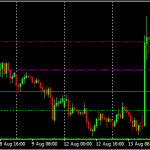- USDJPY coils below a falling trend and struggles at the right shoulder in an inverse head and shoulders pattern formation. Bullish bias here.
One of the most interesting currency pairs of the F.X. dashboard, the USDJPY consolidates for quite some time. If we zoom out on the bigger timeframes to see as many candlesticks as possible, we see that the pair is trapped below a falling trend, unable to break higher regardless of what is happening around the world.
The last time we saw a meaningful break on the USDJPY was four years ago. Trump’s election generated a strong stock market reaction. Back in the day, the USDJPY was correlated with the Dow Jones and the S&P500, because the JPY was one of the currencies with the lower interest rate. Nowadays, that correlation broke, and it looks like the USDJPY pair lost its mojo.
Since 2016, the JPY kept its safe-haven status. Just like the CHF, the JPY is bought in times when investors look for safety. The ongoing U.S.- China trade deal uncertainty, the nuclear games played by South Korea, etc. – they all played a role in keeping the USDJPY pair down.
Therefore, it is very likely that we will see a true reaction only by the time the U.S. elections end a few months from now.
USDJPY Technical Analysis
The pair was one of the first ones to recover the March 2020 COVID-19 dip. After the initial shock, though, buyers stepped in, and then a consolidation started. Although having a declining angle, the consolidation looks like the right shoulder of a head and shoulders pattern, and the March decline the head of the pattern.
USDJPY reacted twice from the 105 level, and that is a place where aggressive traders might step in. However, the ideal setup is to see a reversal pattern from that area, like a hammer, bullish engulfing, or at least a Doji candlestick. This way, it is easier to set the stop loss and the take profit by taking into consideration the risk and the reward by using a risk-reward ratio of 1:3.
Dow Jones Daily Chart





